Amantadine attenuates sepsis-induced cognitive dysfunction possibly not through inhibiting toll-like receptor 2
- PMID: 29502203
- PMCID: PMC5902799
- DOI: 10.1007/s00109-018-1631-z
Amantadine attenuates sepsis-induced cognitive dysfunction possibly not through inhibiting toll-like receptor 2
Abstract
Amantadine has been shown to reduce anesthesia and surgery-induced neuroinflammation and cognitive dysfunction. It is known that sepsis can impair brain function. We determined whether amantadine-attenuated sepsis-induced neuroinflammation and dysfunction of learning and memory and whether toll-like receptors (TLRs) play a role in the effects. Six- to eight-week-old mice were subjected to cecal ligation and puncture (CLP). Amantadine at 30 mg/kg/day was injected intraperitoneally for 3 days. CU-CPT22, a TLR1/TLR2 inhibitor, at 3 mg/kg/day was injected intraperitoneally for 2 days. Mice were subjected to Barnes maze and fear conditioning tests from 1 week after CLP. CLP induced neuroinflammation and cognitive dysfunction. CLP also increased the expression of toll-like receptor 2 (TLR2), TLR4, and TLR9, three major TLRs in the brain, in CD-1 male mice. Amantadine attenuated CLP-induced neuroinflammation and dysfunction of learning and memory but did not have significant effects on the expression of TLRs. CU-CPT22 also attenuated sepsis-induced neuroinflammation and cognitive dysfunction. Similarly, sepsis induced neuroinflammation and cognitive dysfunction in the C57BL/6J mice. Interestingly, sepsis also induced neuroinflammation and cognitive dysfunction in the TLR2 knockout mice. The effects of amantadine on the neuroinflammation and cognitive dysfunction were still apparent in these knockout mice. TLR2 contributes to sepsis-induced neuroinflammation and cognitive dysfunction. However, inhibiting TLR2 may not be a major mechanism for amantadine to inhibit sepsis-induced neuroinflammation and cognitive dysfunction.
Key messages: Sepsis induces neuroinflammation and cognitive impairment, which were attenuated by amantadine. Toll-like receptors 2 mediates these sepsis effects but may not be the major target for amantadine to reduce these effects.
Keywords: Amantadine; Cognitive function; Neuroinflammation; Sepsis; Toll-like receptors.
Conflict of interest statement
Figures
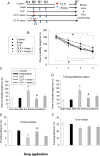

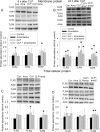

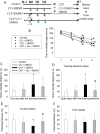
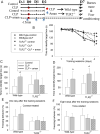
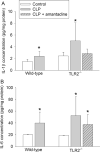
Similar articles
-
Toll-like receptor 2 activation and up-regulation by high mobility group box-1 contribute to post-operative neuroinflammation and cognitive dysfunction in mice.J Neurochem. 2021 Jul;158(2):328-341. doi: 10.1111/jnc.15368. Epub 2021 May 5. J Neurochem. 2021. PMID: 33871050 Free PMC article.
-
INT-777 prevents cognitive impairment by activating Takeda G protein-coupled receptor 5 (TGR5) and attenuating neuroinflammation via cAMP/ PKA/ CREB signaling axis in a rat model of sepsis.Exp Neurol. 2021 Jan;335:113504. doi: 10.1016/j.expneurol.2020.113504. Epub 2020 Oct 13. Exp Neurol. 2021. PMID: 33058889
-
Hydrogen gas alleviates blood-brain barrier impairment and cognitive dysfunction of septic mice in an Nrf2-dependent pathway.Int Immunopharmacol. 2020 Aug;85:106585. doi: 10.1016/j.intimp.2020.106585. Epub 2020 May 21. Int Immunopharmacol. 2020. PMID: 32447221
-
What animal models can tell us about long-term cognitive dysfunction following sepsis: A systematic review.Neurosci Biobehav Rev. 2021 May;124:386-404. doi: 10.1016/j.neubiorev.2020.12.005. Epub 2020 Dec 9. Neurosci Biobehav Rev. 2021. PMID: 33309906
-
Toll-like receptor-mediated neuroinflammation: relevance for cognitive dysfunctions.Trends Pharmacol Sci. 2022 Sep;43(9):726-739. doi: 10.1016/j.tips.2022.05.004. Epub 2022 Jun 23. Trends Pharmacol Sci. 2022. PMID: 35753845 Free PMC article. Review.
Cited by
-
Perioperative Neurocognitive Disorder: State of the Preclinical Science.Anesthesiology. 2020 Jan;132(1):55-68. doi: 10.1097/ALN.0000000000002956. Anesthesiology. 2020. PMID: 31834869 Free PMC article. Review.
-
The role of the peripheral system dysfunction in the pathogenesis of sepsis-associated encephalopathy.Front Microbiol. 2024 Jan 17;15:1337994. doi: 10.3389/fmicb.2024.1337994. eCollection 2024. Front Microbiol. 2024. PMID: 38298892 Free PMC article. Review.
-
Dexmedetomidine attenuates sepsis-associated inflammation and encephalopathy via central α2A adrenoceptor.Brain Behav Immun. 2021 Jan;91:296-314. doi: 10.1016/j.bbi.2020.10.008. Epub 2020 Oct 8. Brain Behav Immun. 2021. PMID: 33039659 Free PMC article.
-
Amantadine Alleviates Postoperative Cognitive Dysfunction Possibly by Preserving Neurotrophic Factor Expression and Dendritic Arborization in the Hippocampus of Old Rodents.Front Aging Neurosci. 2020 Nov 26;12:605330. doi: 10.3389/fnagi.2020.605330. eCollection 2020. Front Aging Neurosci. 2020. PMID: 33324197 Free PMC article.
-
Mast cell activation mediates blood-brain barrier impairment and cognitive dysfunction in septic mice in a histamine-dependent pathway.Front Immunol. 2023 Feb 1;14:1090288. doi: 10.3389/fimmu.2023.1090288. eCollection 2023. Front Immunol. 2023. PMID: 36817492 Free PMC article.
References
-
- Gofton TE, Young GB. Sepsis-associated encephalopathy. Nat Rev Neurol. 2012;8:557–566. - PubMed
-
- Sprung CL, Peduzzi PN, Shatney CH, Schein RM, Wilson MF, Sheagren JN, Hinshaw LB. Impact of encephalopathy on mortality in the sepsis syndrome. The Veterans Administration Systemic Sepsis Cooperative Study Group. Crit Care Med. 1990;18:801–806. - PubMed
-
- Winters BD, Eberlein M, Leung J, Needham DM, Pronovost PJ, Sevransky JE. Long-term mortality and quality of life in sepsis: a systematic review. Crit Care Med. 2010;38:1276–1283. - PubMed
Publication types
MeSH terms
Substances
Grants and funding
LinkOut - more resources
Full Text Sources
Other Literature Sources
Medical
Miscellaneous

